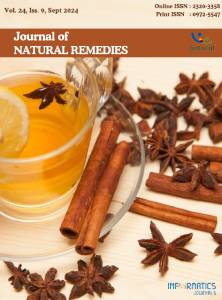Stability Indicating HPTLC Method for Estimation of Cubebin in Crude Drug and Marketed Formulations
DOI:
https://doi.org/10.18311/jnr/2024/43896Keywords:
Cubebin, Dhanwantari Vati, Khadiradi Vati, Piper cubebaAbstract
Background: Cubebin is a naturally occurring lactone lignan isolated from the plant species Piper cubeba. It exhibits a range of biological activities, including anti-inflammatory, antimicrobial, and anticancer properties. This compound has garnered significant interest for its potential therapeutic applications in traditional and modern medicine. Aim: This study aimed to develop a novel stability-indicating High-Performance Thin Layer Chromatography (HPTLC) technique that is simple yet precise in estimating cubebin in crude drug and marketed formulations. Method: Cubebin was estimated using precoated TLC silica gel 60 F254 plate as a stationary phase and n-hexane: ethyl acetate: formic acid: methanol (6:3.5:0.5:0.3 v/v/v/v) as a mobile phase with the chamber saturation time of 20 mins. Key Findings: Cubebin was detected and quantified at the wavelength of 283nm. The Rf value of cubebin in standard solution, Piper cubeba extract, Dhanwantari Vati, and Khadiradi Vati was found to be 0.494±0.0015, 0.492±0.002, 0.490±0.0020, 0.499±0.001 respectively. The calibration curve exhibited linearity within the range of 3000-13000 ng per band with a correlation coefficient (r2) of Cubebin was 0.9968. The method developed was utilized for the quantitation of cubebin in Piper cubeba and both the marketed formulations. Conclusion: A novel HPTLC method was developed and validated in accordance to ICH guidelines for the analysis of cubebin in crude drug and marketed formulations. The method was found to be simple, precise, accurate, and specific. This method is suitable for quality control and stability testing of cubebin-containing formulations.
Downloads
Metrics
Downloads
Published
How to Cite
Issue
Section
Categories
License
Copyright (c) 2024 Mansi Patel, Tanvi Dodiya, Disha Prajapati (Author)

This work is licensed under a Creative Commons Attribution 4.0 International License.
Accepted 2024-07-05
Published 2024-10-07
References
Bhowmik D, Kumar KS, Tripathi P, Chiranjib B. Traditional herbal medicines: An overview. Archives of Applied Science Research. 2009; 1(2):165-77.
Mulik MB, Laddha KS. Isolation, characterization, and quantification of bioactive dibenzylbutyrolactone lignan (-)-cubebin from fruits of Piper cubeba L. Indian Journal of Natural Products and Research. 2015;6(3):189-193. http:// nopr.niscpr.res.in/handle/123456789/32673
Godoy de Lima R, Barros MT, da Silva Laurentiz R. Medicinal attributes of Lignans extracted from Piper cubeba: Current developments. Chemistry Open. 2018; 7(2):180-91. https://doi.org/10.1002/open.201700182 PMid:29435403 PMCid:PMC5795757
Kumar P. A review on medicinal plant Piper cubeba L. and its pharmaceutical properties. International Journal of the Science of Food and Agriculture. 2021; 5(1):174-179. https://doi.org/10.26855/ijfsa.2021.03.022
ICH guidelines, Q1A (R2): Stability testing of new drug substances and products (revision 2), International Conference on Harmonization. Available from: (http://www.fda.gov/downloads/RegulatoryInformation/ Guidances/ucm128204.pdf), 2003.
Bakshi M, Singh S. Development of validated stabilityindicating assay methods-critical review. Journal of Pharmaceutical and Biomedical Analysis. 2002; 28(6):101140. https://doi.org/10.1016/S0731-7085(02)00047-X PMid:12049968
Srivastava M, editor. High-Performance Thin-Layer Chromatography (HPTLC). Springer Science and Business Media. 2010. p. 15. https://doi.org/10.1007/978-3-642-14025-9
Kamboj A, Saluja AK. Development of validated HPTLC method for quantification of stigmasterol from leaf and stem of Bryophyllum pinnatum. Arabian Journal of Chemistry. 2010; 10:S2644-50. https://doi.org/10.1016/j.arabjc.2013.10.006

 Mansi Patel
Mansi Patel









 0.35
0.35 24
24 0.161
0.161